Modern marriage evolved from a historical ritual designed to indenture slaves to masters, though most people have forgotten its history. However, many of the behaviors and rituals central to this history can still be discerned in modern marriage.
 It’s thought that the practice of exchanging wedding rings extends far back into ancient history, with evidence of the ritual being found in Ancient Egypt, Rome, and within several religious cultures. However our modern-day practice of giving wedding rings has a very different origin and meaning, one which may make you, well, cringe a little. As suggested on the Society of Phineas blog, the ring functions as a feudalistic contract between the man and his wife:
It’s thought that the practice of exchanging wedding rings extends far back into ancient history, with evidence of the ritual being found in Ancient Egypt, Rome, and within several religious cultures. However our modern-day practice of giving wedding rings has a very different origin and meaning, one which may make you, well, cringe a little. As suggested on the Society of Phineas blog, the ring functions as a feudalistic contract between the man and his wife:
“The ring functions as a proof of ability in the supplicant vassal’s pledge to the wife. This is true given the traditional expectation of the amount of resources to be expended in purchasing the ring along with providing for the wedding day. In this gynocentric environment, it’s total sacrilege to not present a woman with her One Ring or to present one that is substandard to her or her friends. She uses her One Ring as a social proof of her status around Team Woman (it’s a competition much like Valentine’s Day gifts), as she will not hesitate to show it off as much as possible when she first gets it if it meets with her approval.” 1
This contention finds support from medievalist scholars who show the origin of our ring-exchanging ritual in early literary sources and artistic depictions of the Middle Ages. H.J. Chaytor, for instance wrote “The lover was formally installed as such by the lady, took an oath of fidelity to her and received a kiss to seal it, a ring or some other personal possession.” Professor Joan Kelly gives us a summary of the practice:
“A kiss (like the kiss of homage) sealed the pledge, rings were exchanged, and the knight entered the love service of his lady. Representing love along the lines of vassalage had several liberating implications for aristocratic women. Most fundamental, ideas of homage and mutuality entered the notion of heterosexual relations along with the idea of freedom. As symbolized on shields and other illustrations that place the knight in the ritual attitude of commendation, kneeling before his lady with his hands folded between hers, homage signified male service, not domination or subordination of the lady, and it signified fidelity, constancy in that service.” 2
 Like the description given by Kelly, men continue to go down on one knee and are quick to demonstrate humility by claiming the wedding is “her day”, betraying the origin and conception of marriage as more feudalistic in its structure than Christian. With gestures like these it’s obvious that modern marriage is based on the earlier feudalistic ritual known as a ‘commendation ceremony‘ whereby a bond between a lord and his fighting man (ie. his vassal) was created. The commendation ceremony is composed of two elements, one to perform the act of homage and the other an oath of fealty. For the Oath of fealty ceremony the vassal would place his hands on a Bible (as is still practiced) and swear he would never injure his overlord in any way and would remain faithful. Once the vassal had sworn the oath of fealty, the lord and vassal had a feudal relationship.
Like the description given by Kelly, men continue to go down on one knee and are quick to demonstrate humility by claiming the wedding is “her day”, betraying the origin and conception of marriage as more feudalistic in its structure than Christian. With gestures like these it’s obvious that modern marriage is based on the earlier feudalistic ritual known as a ‘commendation ceremony‘ whereby a bond between a lord and his fighting man (ie. his vassal) was created. The commendation ceremony is composed of two elements, one to perform the act of homage and the other an oath of fealty. For the Oath of fealty ceremony the vassal would place his hands on a Bible (as is still practiced) and swear he would never injure his overlord in any way and would remain faithful. Once the vassal had sworn the oath of fealty, the lord and vassal had a feudal relationship.
Because this archaic contract remains current in contemporary marriages, we might also question our typical concepts of obeyance between a husband and wife. In older Christian ceremonies the women sometimes vowed to love, cherish and “obey” her husband. However, because framed within a feudalistic-style relationship the woman’s obeyance was strongly offset and perhaps overturned in practice because she tended to be the dominant power-holder in relation to the man. In the latter case the wife as more powerful figure is merely obeying -if she is obeying anything at all- her responsibilities as a kindly overlord to her husband. Notice here that we have switched from the notion of a benevolent patriarchy to a kindly gynocentrism which feminists like to promote as loving, nurturing, peace-loving and egalitarian.
Love service
The Medieval model of service to a feudal lord was transferred wholesale into relationships as “love service” of men toward ladies. Such service is the hallmark of romantic love and is characterized by men’s deference to a woman who is viewed as a moral superior. During this period women were often referred to by men as domnia (dominant rank), midons (my lord), and later dame (honored authority) which terms each draw their root from the Latin dominus meaning “master,” or “owner,” particularly of slaves. Medieval language expert Peter Makin confirms that the men who used these terms must have been aware of what they were saying:
“William IX calls his lady midons, which I have translated as ‘my Lord’… These men knew their Latin and must have been aware of its origins and peculiarity; in fact it was clearly their collective emotions and expectations that drew what amounts to a metaphor from the area of lordship, just as it is the collective metaphor-making process that establishes ‘baby’ as a term for a girlfriend and that creates and transforms language constantly. In the same way, knowing that Dominus was the standard term for God, and that don, ‘lord’, was also used for God, they must also have felt some connection with religious adoration. 3
Recapitulation
Let’s recapitulate the practices associated with the ring-giving ritual of marriage:
1. Genuflection: man goes down on one knee to propose
2. Commendation token: rings exchanged
3. Vassal’s kiss: reenacted during the ceremony
4. Homage and fealty: implicit in marriage vows
5. Subservience: “It’s her special day”
6. Service: man prepares to work for wife for his whole life
7. Disposability: “I would die for you”.
Is it any wonder that women are so eager to get married and that men are rejecting marriage in droves? The feudalistic model reveals exactly what men are buying into via that little golden band – a life commitment to a woman culturally primed to act as our overlord. As more men become aware of this travesty they will choose to reject it, and for those still considering marriage I encourage you to read this article a second time; your ability to keep or lose your freedom depends upon it.
[youtube=http://www.youtube.com/watch?v=FEr0BPOfVw4&w=560&h=315]
[1] Website: Society of Phineas
[2] Joan Kelly, Women, History, and Theory, University of Chicago Press, 1986
[3] Peter Makin, Provence and Pound, University of California Press, 1978
A “baby” is the dominant member of a household. When the “baby” grows up as is required for a male (i.e., “man up!”), he becomes a vassal as well. The female “baby” however remains one and further her sexuality belongs to her overlord–her mother–who essentially becomes her pimp policing her sexuality, preventing her from choosing any “independence” or alternative arrangement that doesn’t reflect well on the narcissism of the mother, the Queen Ant. The same applies to daughters-in-law. It is no wonder that some prefer to run with the wolves rather than submit to the yoke. Meanwhile, when the queen ants get together the battle is to the death, or in the case of Mary Queen of Scots, execution by proxy. http://www.globalresearch.ca/the-irish-slave-trade-the-forgotten-white-slaves/31076.
Interesting with the Queens – one has to die. Vicious!
Esther Vilar wrote a book entitled ‘The Manipulated Man’ that described feminism as a project exploiting men’s capacity for protecting vulnerable children. The theme of her book is that women (particularly femininsts) act like children in order to receive the attention, protection, and indulgence of men playing the protective adult role.
Thanks for the link, really interesting…
Thanks for the quote. Too true.
What i do not understood is in reality how you are no longer actually a lot more neatly-favored than you may be right now.
You’re very intelligent. You realize thus considerably relating to this
subject, produced me personally imagine it from numerous varied angles.
Its like men and women aren’t involved except it’s something to do with
Lady gaga! Your individual stuffs outstanding.
At all times handle it up!
I love your blog.. very nice colors & theme. Did you make this
website yourself or did you hire someone to do it for you?
Plz reply as I’m looking to construct my own blog and
would like to know where u got this from. appreciate it
This blog sure doesn’t get much attention. How sad. So few comments for such an important expose on the exploitation of men. The content here must be pushed way down in the recommendations list or something. Just sad.
I’ve never heard this medieval explanation before but it makes perfect sense. Marriage is a complete scam today and I judge any man who trusts his financial future to the whims of an emotional basket case either a reckless gambler or a misguided traditionalist cuck.